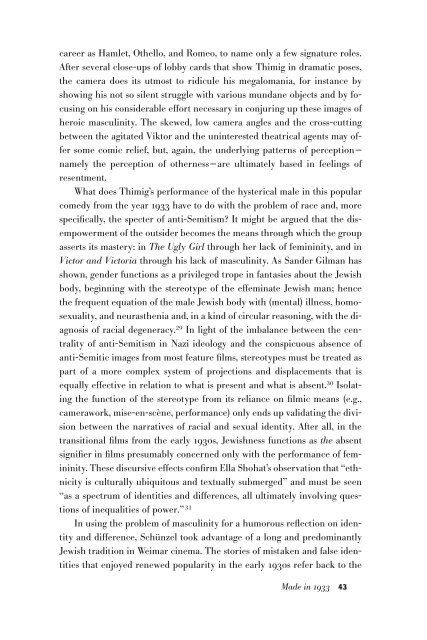You also want an ePaper? Increase the reach of your titles
YUMPU automatically turns print PDFs into web optimized ePapers that Google loves.
career as Hamlet, Othello, and Romeo, to name only a few signature roles.<br />
After several close-ups of lobby cards that show Thimig in dramatic poses,<br />
the camera does its utmost to ridicule his megalomania, for instance by<br />
showing his not so silent struggle with various mundane objects and by focusing<br />
on his considerable effort necessary in conjuring up these images of<br />
heroic masculinity. The skewed, low camera angles and the cross-cutting<br />
between the agitated Viktor and the uninterested theatrical agents may offer<br />
some comic relief, but, again, the underlying patterns of perception—<br />
namely the perception of otherness—are ultimately based in feelings of<br />
resentment.<br />
What does Thimig’s performance of the hysterical male in this popular<br />
comedy from the year 1933 have to do with the problem of race and, more<br />
specifically, the specter of anti-Semitism? It might be argued that the disempowerment<br />
of the outsider becomes the means through which the group<br />
asserts its mastery: in The Ugly Girl through her lack of femininity, and in<br />
Victor and Victoria through his lack of masculinity. As Sander Gilman has<br />
shown, gender functions as a privileged trope in fantasies about the Jewish<br />
body, beginning with the stereotype of the effeminate Jewish man; hence<br />
the frequent equation of the male Jewish body with (mental) illness, homosexuality,<br />
and neurasthenia and, in a kind of circular reasoning, with the diagnosis<br />
of racial degeneracy. 29 In light of the imbalance between the centrality<br />
of anti-Semitism in Nazi ideology and the conspicuous absence of<br />
anti-Semitic images from most feature films, stereotypes must be treated as<br />
part of a more complex system of projections and displacements that is<br />
equally effective in relation to what is present and what is absent. 30 Isolating<br />
the function of the stereotype from its reliance on filmic means (e.g.,<br />
camerawork, mise-en-scène, performance) only ends up validating the division<br />
between the narratives of racial and sexual identity. After all, in the<br />
transitional films from the early 1930s, Jewishness functions as the absent<br />
signifier in films presumably concerned only with the performance of femininity.<br />
These discursive effects confirm Ella Shohat’s observation that “ethnicity<br />
is culturally ubiquitous and textually submerged” and must be seen<br />
“as a spectrum of identities and differences, all ultimately involving questions<br />
of inequalities of power.” 31<br />
In using the problem of masculinity for a humorous reflection on identity<br />
and difference, Schünzel took advantage of a long and predominantly<br />
Jewish tradition in Weimar cinema. The stories of mistaken and false identities<br />
that enjoyed renewed popularity in the early 1930s refer back to the<br />
Made in 1933 43

















